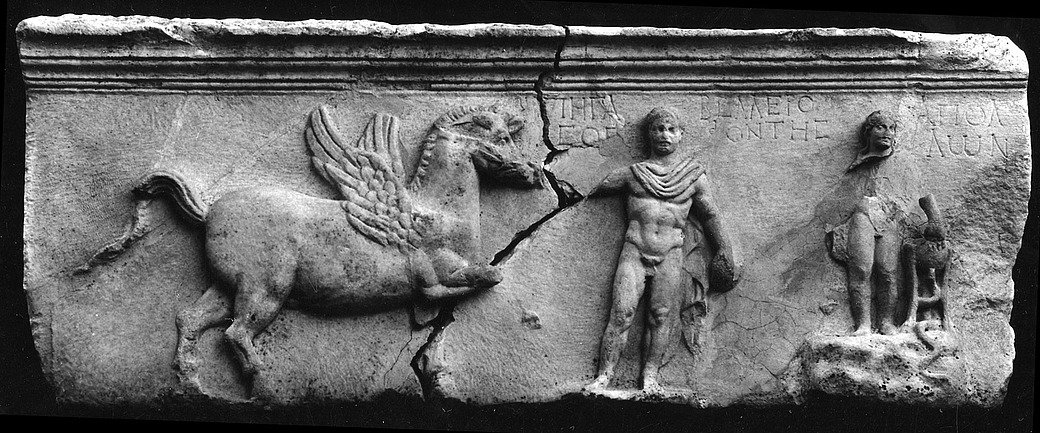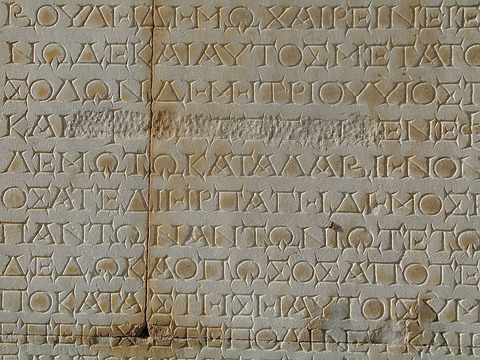In Search of an Identity

“Who are you?” A simple question sometimes requires a complex answer. When a Homeric hero is asked who he is (e.g. Iliad 7.123 ff.), his answer consists of more than just his name; he provides a list of his ancestors. The history of his family is an essential constituent of his identity. When the city of Aphrodisias (in Asia Minor) decided to honor a prominent citizen with a public funeral (ca. 50 B.C.E.), the decree in his honor identified him in the following manner:
Hermogenes, son of Hephaistion, the so-called Theodotos, one of the first and most illustrious citizens, a man who has as his ancestors men among the greatest and among those who built together the community and have lived in virtue, love of glory, many promises of benefactions, and the most beautiful deeds for the fatherland; a man who has been himself good and virtuous, a lover of the fatherland, a constructor, a benefactor of the polis, and a savior . . .
The components of Hermogenes’ identity include his name and nickname (Theodotos = “the gift of the gods”), his social class, the history of his family, and his personal achievements.
We can define “identity” in an elementary manner as the answer to the questions “who and what are you?” Depending on the context in which the question is asked and who wants to know, the answer may vary and change over time.
It is hard to imagine contexts in which a modern-day citizen of a European country when confronted with these questions would give the answer: “I am a European.” And yet discussions about European identity abound, usually tacitly taking the existence of European identity, cultural rather than political, for granted. Studies of how identity was defined in other cultures invites us to critically reflect on modern discourses of European identity.
Ancient Greek paradigms reveal two important aspects: the parallel existence and overlapping of identities and their continual evolution. Let us take the case of Classical and Hellenistic Crete. The elementary identity of a member of a Cretan community was his civic identity––for instance as a citizen of Knossos. This identity was shaped from the earliest childhood on. Listening to narratives of the deeds of the forefathers, a child was introduced to the values, and social and gender roles accepted by his community. Local songs taught him heroic legends; hymns, oaths, and prayers made him familiar with the local gods. Local cultural memory was ritually transmitted during commemorative anniversaries––usually the commemoration of victory and conquest. Identity meant belief in the superiority of one’s community over others. This civic identity was overlaid by other forms of consciousness and solidarity, especially by social identities. For instance, the self-confident song attributed to a certain Hybrias expressed the social identity of the upper class of landowners and warriors:
My great wealth are my spear, sword, and the fine shield, which guards my skin. With this I plough, with this I reap, with this I tread the sweet wine from the vine, with this I am called master of the serfs. Those who do not have the courage to hold a spear, a sword, and the fine shield which guards the skin, all of them fall to their knees and do obeisance and call me lord and great king.
Here again identity means belief of the superiority of the group to which an individual belongs. Civil wars occurred when such social identities undermined the civic one.
In Crete, as in other Greek regions, groups of communities could also define separate regional identities—to a certain extent comparable with the process of European unification: Two or more civic communities could construct a new identity on the basis of a treaty that resulted in their unification. The cities in western Crete established such a federal state, to which they gave a name expressing a new identity: the Oreioi, “those of the mountains,” the “Highlanders.” “My fatherland are the Oreioi” was written on the tombstone of a soldier from this area who was buried in Sparta in the early third century B.C.E. Those who set up the epitaph for this man stressed an identity that stood between the narrower identity of the citizen of a polis and the wider identities of the Cretan and the Greek. When will a Dutchman, a Finn, or a German, buried abroad, have on his tomb written “here rests a European”?
As historical constructs, identities are subject to continual changes. They can be deleted and constructed anew. Aphrodisias, a city in Asia Minor, provides an instructive case in point. Founded by military settlers of mixed origin, primarily Greeks but also Iranians, Karians, and possibly Jews, at the site of Nineuda, near an important sanctuary of an Anatolian goddess, this city was programmatically given the name “the city of Aphrodite” (ca. 180 B.C.E.). The factors that shaped the identity of this community in the earlier period of its existence were war experience—Aphrodisias took the side of Rome against Mithridates VI and of Octavian/ Augustus during the Roman civil wars—and the commemoration of the part played by the founders’ families. Inscriptions, some of them inscribed on a wall of the city’s theater, kept the memory of Aphrodisias’s sacrifices for Rome, for which the city was rewarded with freedom and tax exemption. The inscriptions for the members of the elite state that they were descendants of the men who had jointly built the fatherland.
After the establishment of Augustus’s monarchical rule, Aphrodite, Aeneas’s mother, was the ancestor of the imperial house. This kinship between the founder of Rome and the patron of Aphrodisias was naturally exploited by the Aphrodisians (Figure 1). Other cities of Asia Minor worshipped Aphrodite too, but a city that was named after Aphrodite, “the ancestor of the divine emperors,” clearly had an advantage over other competitors. But the memory of the military achievements started to blur and new challenges occurred. Under Roman rule many cities in the Greek East claimed for themselves mythical origins, and competed on the basis of such claims for privileges and honorary titles.

If the Aphrodisians had continued to commemorate the foundation of their city in the second or first century B.C.E., they would have given up any claim on priority. So, the Aphrodisians had to construct their own mythical past, claiming that the founder of their city was Ninos, the legendary consort of the Assyrian queen Semiramis (ca. eighth century B.C.E.). Presumably, the similarity of Aphrodisias’s early name (Nineuda) with the name of Ninos was responsible for the creation of this legend. But an origin after the Trojan War was not early enough. Another mythological founder was found in the person of Bellerophon (Figure 2). With him, the foundation of Aphrodisias was placed as early in time as one could possibly go. Aphrodisias could be counted among the earliest cities of Asia Minor—a true metropolis. These traditions originate in the circle of the elite. They reflect the constructed identity they wanted to present to Rome and to their neighbors in the “globalized” world of the Roman Empire, in which local identities could primarily be promoted through constructed cultural memories. We do not know how this identity was perceived by other groups, especially by the non-Greek indigenous Karian population and the Jews. This more or less harmonious image of “the most illustrious people of the glorious city of the Aphrodisians, ally of the Romans, devoted to the emperor, free and autonomous according to the decrees of the most holy senate and the treaty and the imperial responses, inviolable” was shattered when the rise of Christianity to state religion brought the conflict of religious identities to the foreground. This conflict ended with the victory of Christianity in the early sixth century. By the mid-seventh century C.E., Aphrodisias had been renamed Stauropolis (“the city of the Cross”) and liberated from its pagan past (Figure 3).

As in Crete or Aphrodisias, identity in Europe is a construct, subject to continual transformations and adaptations to changing environments. But unlike ancient paradigms, typical features of a collective identity are absent in contemporary Europe: a joint European citizenship, a common language (other than bad English), a common religion, joint historical experiences, a common mythology, and a common system of social values. The Europeans have never experienced history together; they have never won (or lost) a war that they have fought together. The images on the reverse of the euro highlight particularities and local patriotisms. The attempts of Europeans (conservative) to found European identity on the alleged superiority of its culture have been rightly criticized and rejected, and European economic supremacy proved ephemeral.
Certain European statesmen and intellectuals promote the idea of a joint cultural memory based on Christian traditions and the cultural roots of Graeco-Roman antiquity. Such a cultural memory is in fact cultural amnesia, the elimination of the memory of the cultural diversity that existed and still exists in Europe––the glamour of Arabic culture in medieval Spain, the power of the Ottoman Empire, European Jewry––and of the countless old and new minorities. There has never been a moment in history that the entire population of Europe spoke the same language, shared the same religion, lived within the borders of the same state, or were subject to a single legal system. There is no such thing as a homogeneous European culture, with which the Bosnian Muslims, the third-generation Turks in Germany, the Greeks, the Roma, the French Jews, the Basques, and the Laps––not to mention the Indians and Pakistanis living in London––can identify themselves. Not the belief in the superiority of a “European culture” will allow the Europeans, both in the continent and in the diaspora, to develop a distinct identity, but the belief in the superiority of joint values: democracy, sensitivity toward human rights and civil liberties, tolerance of diversity, commitment to unprejudiced advance in knowledge, and protection of the environment.


